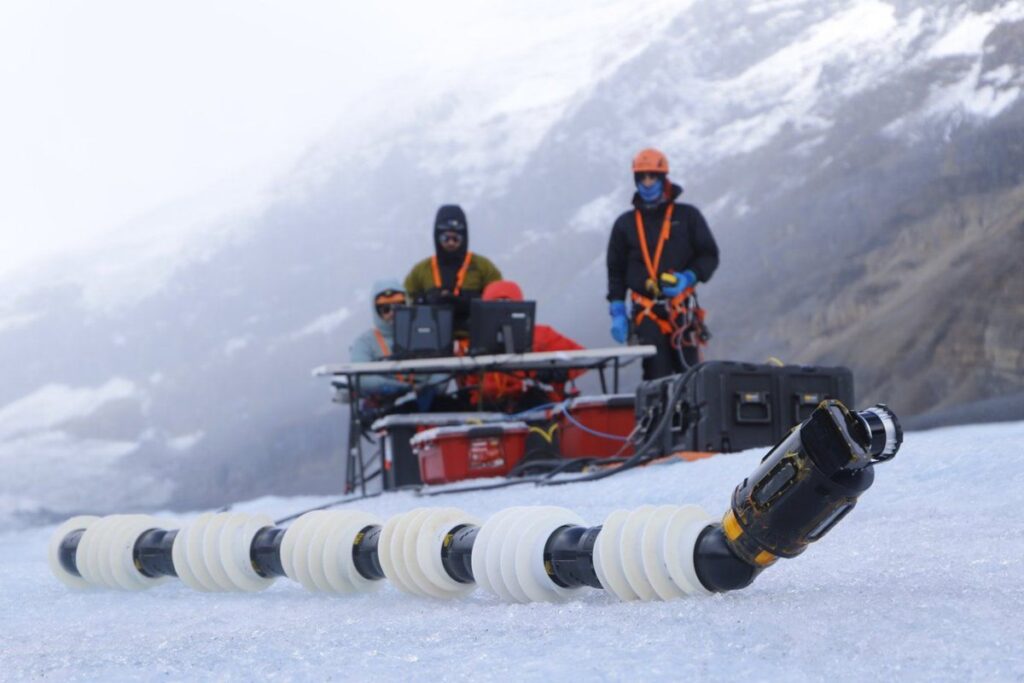The device (its acronym expands to Exobiology Extant Life Surveyor) is essentially a mechanical snake that is 15 feet long, weighs 200 pounds, and has a diameter of 10 centimeters.
NASA recently conducted some field tests in Jasper National Park, and a rather unique piece of equipment was tested in a very specific field.
Scientists at the US space agency’s Jet Propulsion Laboratory (JPL) brought EELS to the Athabasca Glacier in September. The device (its acronym expands to Exobiology Extant Life Surveyor) is essentially a mechanical snake that is 15 feet long, weighs 200 pounds, and has a diameter of 10 centimeters.
JPL scientist Dr. Morgan Cable said EELS is intended to do things that rovers (such as Mars rovers) cannot manage or maneuver because some of the slopes are too steep.
“They still have some limitations. They can’t access hard-to-reach places.”
NASA now recognizes that microbes may not be hanging on the surface of Mars, Europa, or Enceladus, but instead exist in tiny or hidden locations, fully exposed to extreme pressures and temperatures. .
“EELS is an example of a robotic architecture designed to reach hard-to-access places, and could potentially lead to a deeper, deeper understanding of whether life exists elsewhere in the solar system. I look forward to it,” Cable said.
Cable and her team also tested EELS at other locations, including at their facility called Mars Yard and at a ski resort near the research headquarters in Pasadena, California. They spent several weeks at the Athabasca Glacier site in the fall, driving EELS through an area that offers scenery like no other.
One is the tour bus. These were useful for heavy robots and all the support equipment that had to be packed.
“Another advantage of the Athabasca Glacier is that there are a lot of features that we really want to test in an icy environment like Europa or Enceladus. There are cracks and crevasses in the ice… moulins. It’s like a conduit that tends to go all the way down to the bottom.”
These Mulans are also interesting from an earth science perspective. Her team made several measurements for her geoscience colleagues, who will use the information in future scientific papers.
“What we’ve been able to do is bring all of these capabilities together in one accessible place,” Cable said.
“We really loved working with our colleagues in that community, and we’re also very excited to be welcomed into the Earth Sciences Cryosphere community. It’s been a really rewarding experience.”
Cable and her JPL team have visited glaciers in the past with the EELS project, but only the snake’s head had most of the sensory equipment in place. It is equipped with numerous imagers and her LiDAR, which is a laser 3D mapping device.
This fall was the first time they brought in two EELS prototypes. One was his full-scale EELS to test horizontal mobility on the surface, and the other was basically some modules. EELS is designed to be extensible, so teams can add or remove modules as the situation demands.
This latest test was successful.
“I was very pleased,” Cable said. “We learned a lot about how the robot behaves in different types of terrain and different environments around it. We also collected a lot of scientific data.”
Additionally, we were able to generate a large number of LiDAR maps that can later be used to test autonomy and other things in silico, also known as digital space.
“We also made some measurements using one of the instruments that fit into the EELS module,” Cable said, adding that “while being submerged in some of these instruments, we know that “We were able to technically detect all kinds of salts that are important for life.” Glacial streams and other liquid areas. ”
Testing continues, including autonomy programming of the EELS. NASA may return to Jasper National Park for further research. or…
“We might see a small mini-version of EELS on the moon or Mars,” Cable said. “Who knows what will happen next? I think this has laid the foundation for many potential opportunities down the road.”

